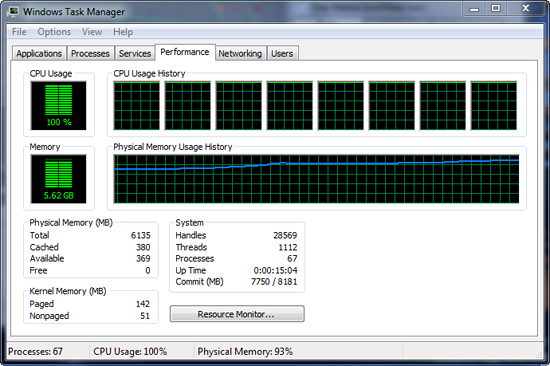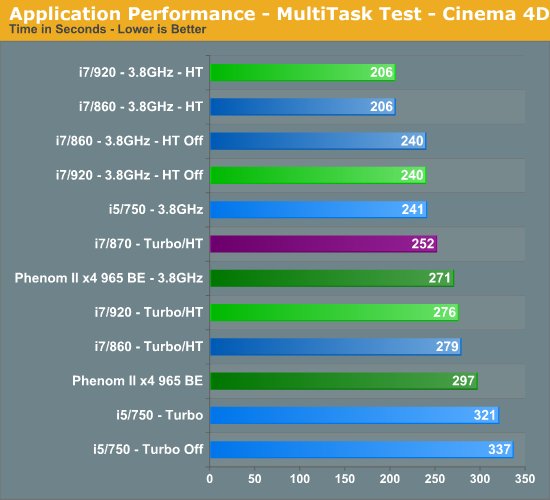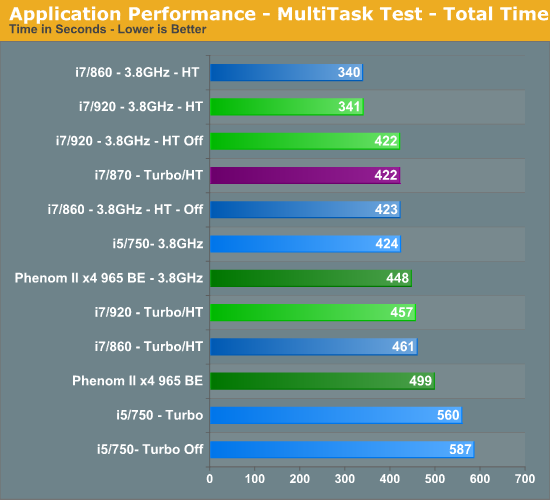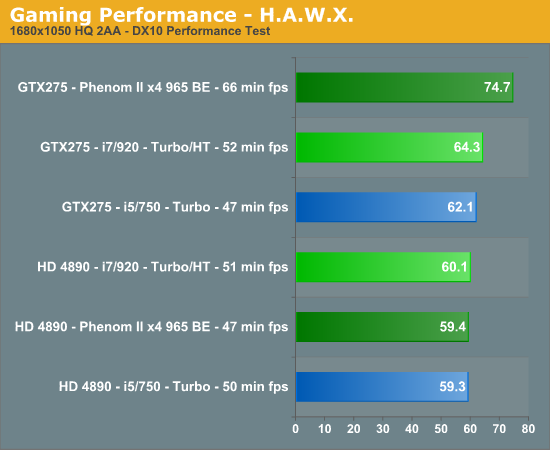i5 / P55 Lab Update - Now with more numbers
by Gary Key on September 15, 2009 12:05 AM EST- Posted in
- Motherboards
Multitasking-
The vast majority of our benchmarks are single task events that utilize anywhere from 23MB up to 1.4GB of memory space during the course of the benchmark. Obviously, this is not enough to fully stress test our 6GB or 8GB memory configurations. We devised a benchmark that would simulate a typical home workstation and consume as much of the 6GB/8GB as possible without crashing the machine.
We start by opening two instances of Internet Explorer 8.0 each with six tabs opened to flash intensive websites followed by Adobe Reader 9.1 with a rather large PDF document open, and iTunes 8 blaring the music selection of the day loudly. We then open two instances of Lightwave 3D 9.6 with our standard animation, Cinema 4D R11 with the benchmark scene, Microsoft Excel and Word 2007 with large documents, and finally Photoshop CS4 x64 with our test image.

Before we start the benchmark process, our idle state memory usage is 4.05GB. Sa-weet!

We wait two minutes for system activities to idle and then start playing Pinball Wizard via iTunes, start the render scene process in Cinema 4D R11, start a resize of our Photoshop image, and finally the render frame benchmark in Lightwave 3D. Our maximum memory usage during the benchmark is 5.62GB with 100% CPU utilization across all four or eight threads.



So far, our results have pretty much been a shampoo, rinse, and repeat event. I believe multitasking is what separates good systems from the not so good systems. I spend very little time using my system for gaming and when I do game, everything else is shutdown to maximize frame rates. Otherwise, I usually have a dozen or so browser windows open, music playing, several IM programs open and in use, Office apps, and various video/audio applications open in the background.
One or two of those primary applications are normally doing something simultaneously, especially when working. As such, I usually find this scenario to be one of the most demanding on a computer that is actually utilized for something besides trying to get a few benchmark sprints run before the LN2 pot goes dry.
The i5/750 results actually surprised me. The system never once felt “slow” but the results do not lie. The i5/750 had its head served on a platter at stock speeds, primarily due to the lack of Hyper-Threading when compared to the other choices. The 965 BE put up very respectable numbers and scaled linearly based on clock speed. An 11% increase in clock speed resulted in a 10% improvement in the total benchmark score for the 965 BE. You cannot ask for more than that.
At 3.8GHz clock speeds, it is once again a tossup between the 920 and 860 processors with HT enabled. The 920 did hold a slight advantage over the 860 at stock clock settings, attributable to slightly better data throughput when under load conditions. Otherwise, on the Intel side the i7/870 provided excellent results based on its aggressive turbo mode, although at a price.
Gaming-
We utilize the Ranch Small demo file along with the FarCry 2 benchmark utility. This particular demo offers a balance of both GPU and CPU performance.

We utilize FRAPS to capture our results in a very repeatable section of the game and report the median score of our five benchmark runs. H.A.W.X. responds well to memory bandwidth improvements and scales linearly with CPU and GPU clock increases.

Your eyes are not deceiving you. After 100+ clean OS installs, countless video card, motherboard, memory and driver combinations, we have results that are not only repeatable, but appear to be valid. We also tracked in-game performance with FRAPS and had similar results. Put simply, unless we have something odd going on with driver optimizations, a BIOS bug, or a glitch in the OS, our NV cards perform better on the AMD platform than they do on the Intel platform. The pattern reverses itself when we utilize the AMD video cards.
It is items like this that make you lose hair and delay articles. Neither of which I can afford to have happen. However, we have several suppliers assisting us with the problem (if it is a problem) and hope to have an answer shortly. These results also repeat themselves in other games like H.A.W.X. and Left 4 Dead but not in Crysis Warhead or Dawn of War II. So, besides the gaming situation, we also see a similar pattern in AutoCad 2010 and other 3D rendering applications where GPU acceleration is utilized, it is just not as pronounced.










77 Comments
View All Comments
yacoub - Tuesday, September 15, 2009 - link
We really need the P55 motherboard reviews. That's where we (hopefully) learn about temps, stability, power draw, features, etc. I certainly won't be buying until I read reviews for the P55 boards.Stradigos - Tuesday, September 15, 2009 - link
I agree! I can't wait to read it. I won't be buying anything till I do.strikeback03 - Tuesday, September 15, 2009 - link
I'm waiting on the same thing. The ~$50 difference between a P55/860 system and an X58/920 system isn't enough to affect my decision much, but this article mentions in passing that the P55/860 system uses 70W less, which would be a definite consideration for me. I'm waiting to see whether this is only in stock configuration or if there is also a difference when overclocked, temps on good air coolers, etc.jonup - Tuesday, September 15, 2009 - link
I'm with you. I am upgrading within the next 6 months and if the i5/p55 is worth the money I will be jumping on it sooner rather than later. Microcenter has the i5 for $170 after MI sales tax. I would of pull the triger but there is not enough MB reviews yet.Gary Key - Tuesday, September 15, 2009 - link
I am not going to wait much longer, just about every person I have contacts with is working on the NV problem. I just hate showing numbers with the knowledge that something is not right. It is not just games, the 3D Rendering apps like Cinema 4D are affected also. That said, I have spent the better part of the last three days testing with the HD4890. ;)CB434 - Tuesday, September 15, 2009 - link
Gary, this GPU issue...Is it that the i5 and i7 is "underperforming" and is getting less FPS than it is expected to (relative to other benchmarks). Or is it simply that the AMD/275 combo is simply better then expected? Is there a "problem" with the i5/i7 and the 275GTX per se? If there was no AMD/275 test, would you have thought there was a problem?
I'm confused about which is which.
Are your contacts Intel people, trying to find a reason for the "problem" or are they AMD people trying to find an explanation for their "success"?
For the record I've been hunting down 275GTX reviews for quite a while and this is the first I've been able to find using a Phenom II and a 275GTX (no chance of ever finding 275GTX SLI on Phenom :(.. ) It's always an i7 in the GPU test rigs. So finding a frame of reference or baseline for how 275GTX is supposed to work with Phenom CPU's is hard because there is nothing out there.
GeorgeH - Tuesday, September 15, 2009 - link
From other reports I've seen on this issue, it really is a problem and it's specific to 1136/1366 - a high-end 775 C2Q would have performed pretty much identically to the X4 965.Bottom line, LGA775+GT200 looks to be a superior gaming platform to a i7+GT200 right now.
Source (bottom of page):
http://techreport.com/articles.x/17545/6">http://techreport.com/articles.x/17545/6
yacoub - Tuesday, September 15, 2009 - link
So is this issue unique to the P55 boards, or do the X58 (or whatever the i7 920 runs on) exhibit this same issue when running the same NVidia drivers and Win7?If the issue isn't unique to P55, it's not really a factor in which P55 motherboard to buy if they all exhibit the same behavior and the X58 boards do as well.
CB434 - Tuesday, September 15, 2009 - link
That's why turbo mode is so cool.You can get all the upsides of a 24/7 3.8Ghz overclock without the extra heat and power usage. You can OC to 3.2 24/7 and let turbo do the rest. For single and dual core turbo it will shut off the other 2/3 cores, meaning more hz for less power consumed and heat generated. Turbo can give you all the upsides without the downsides, or at least the downsides are reduced.
jeffj29 - Tuesday, September 15, 2009 - link
So it looks like OC'd at 3.8 GHz with HT on that it's a dead heat performance-wise between the x58/920 and then p55/860 platform.The 860 combo would have lower cost but the 920 combo have greater future upgrade performance potential (with a future 6-core processor). But here is the question I am most curious about... how much higher would a 920 (with D0 stepping) overclock to using air cooling than a 860? For example, if the 920 overclocks easily to 4.0 GHz but the 860 wouldn't OC stable past 3.8 GHz then the 960 would be the clear performance pick in my book.